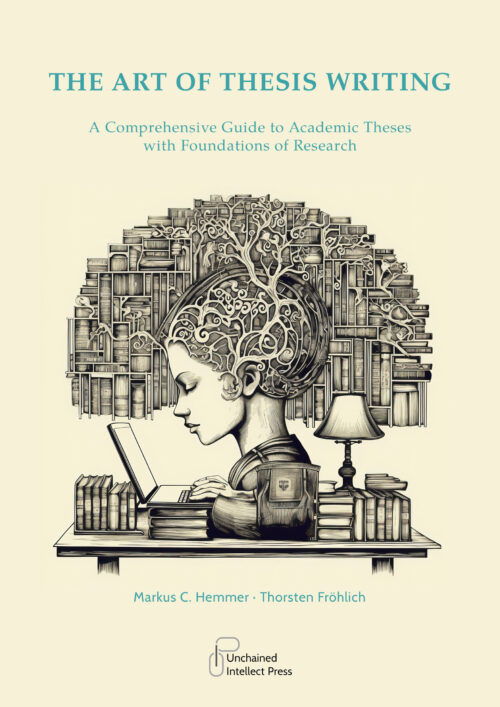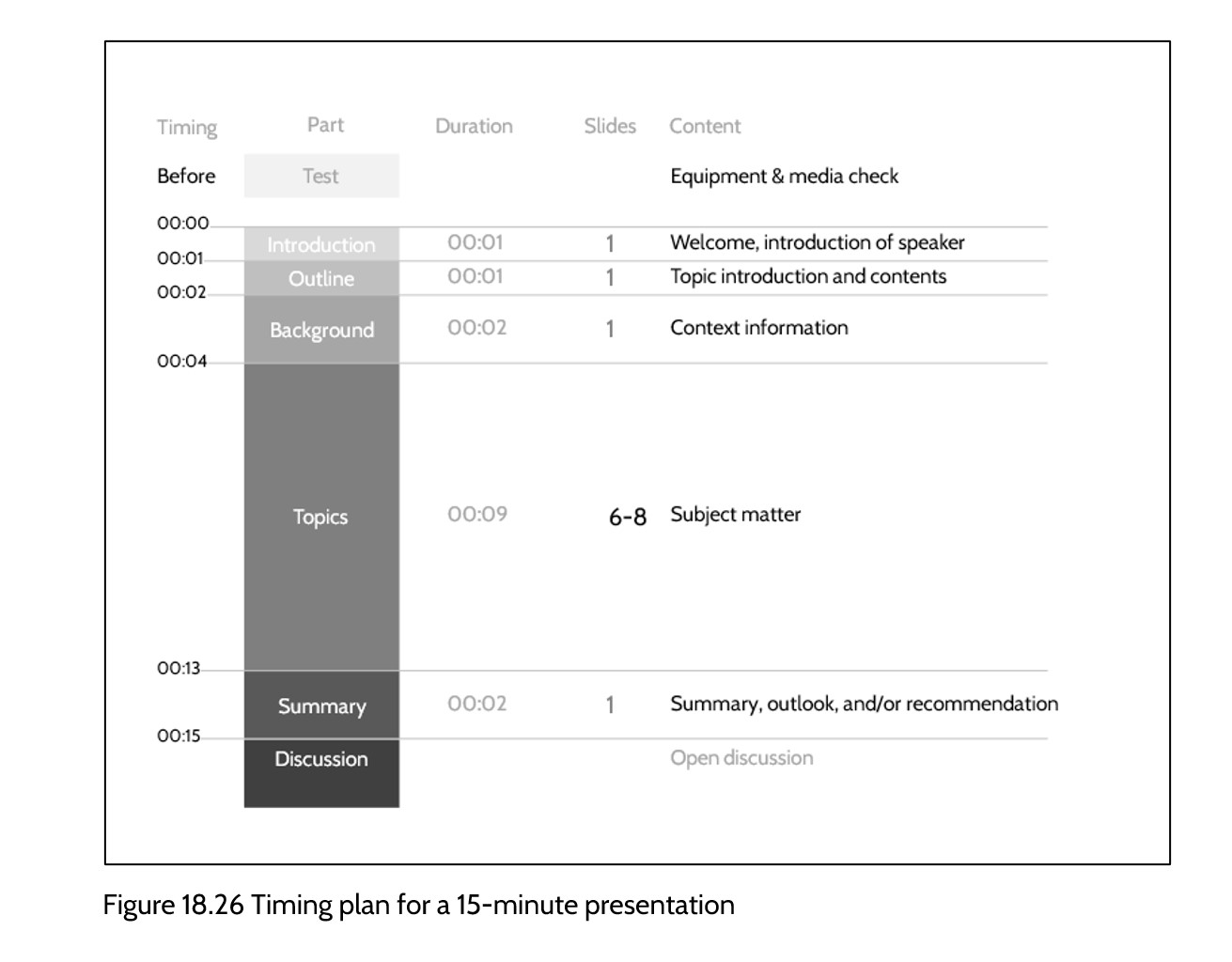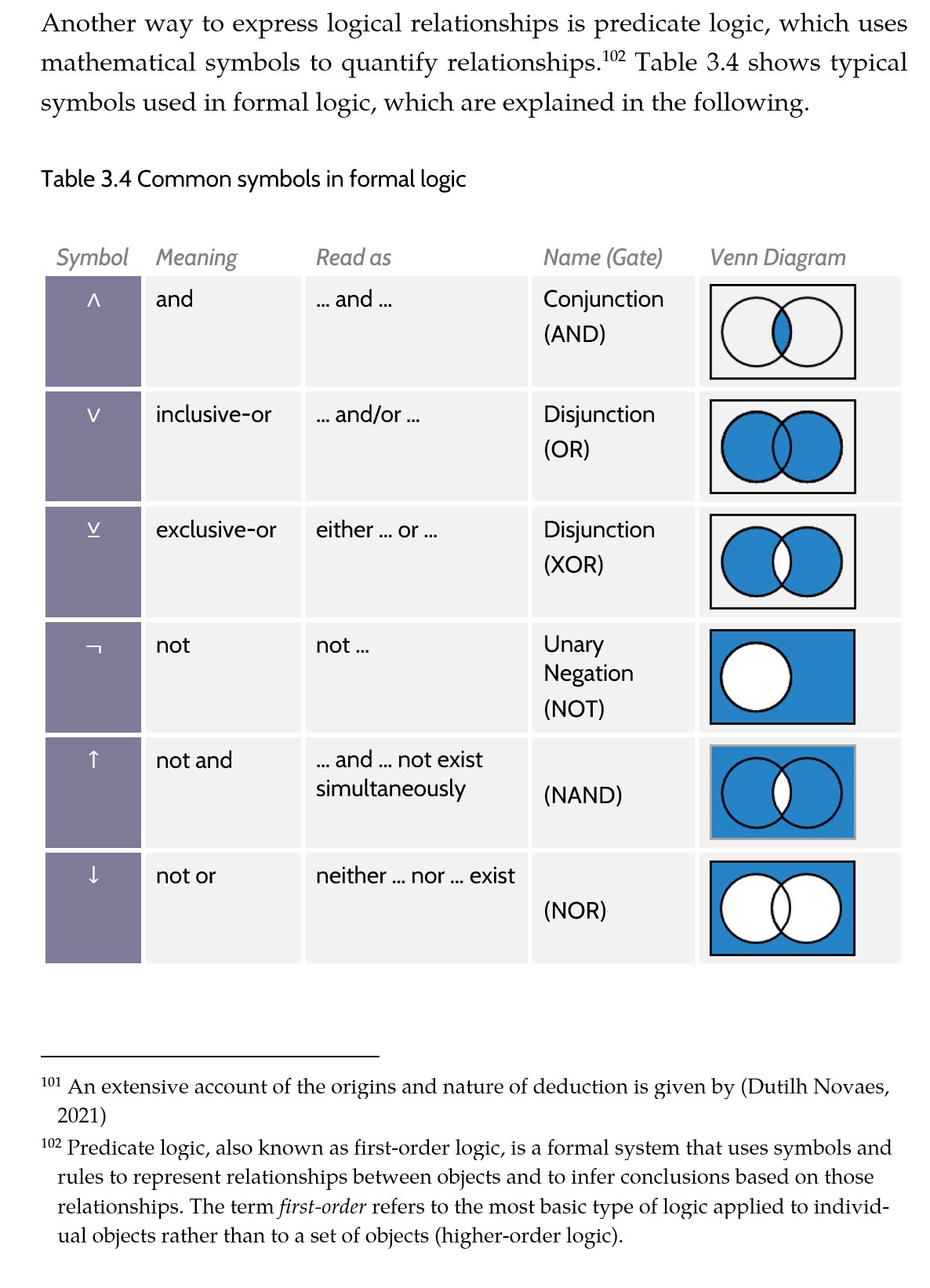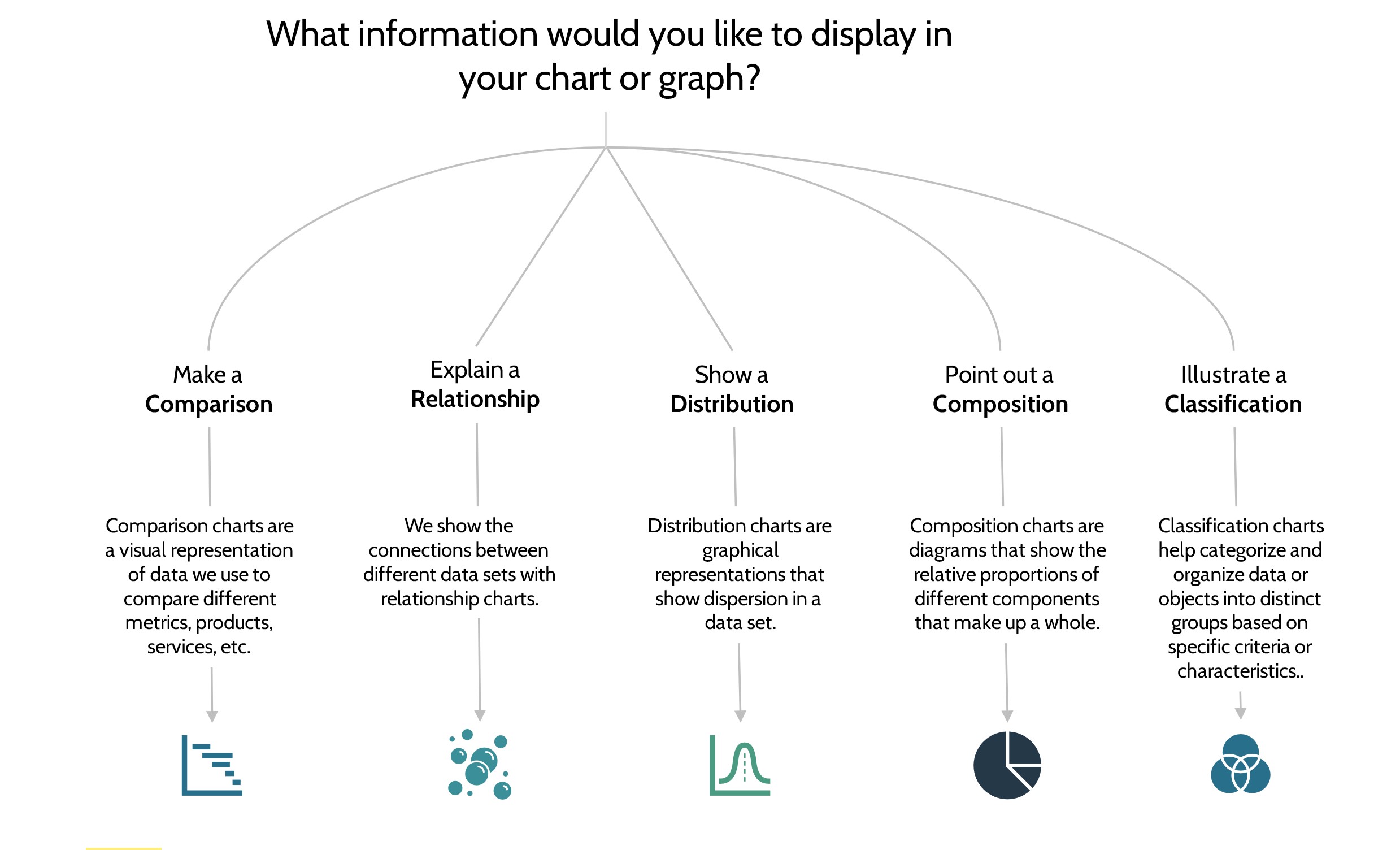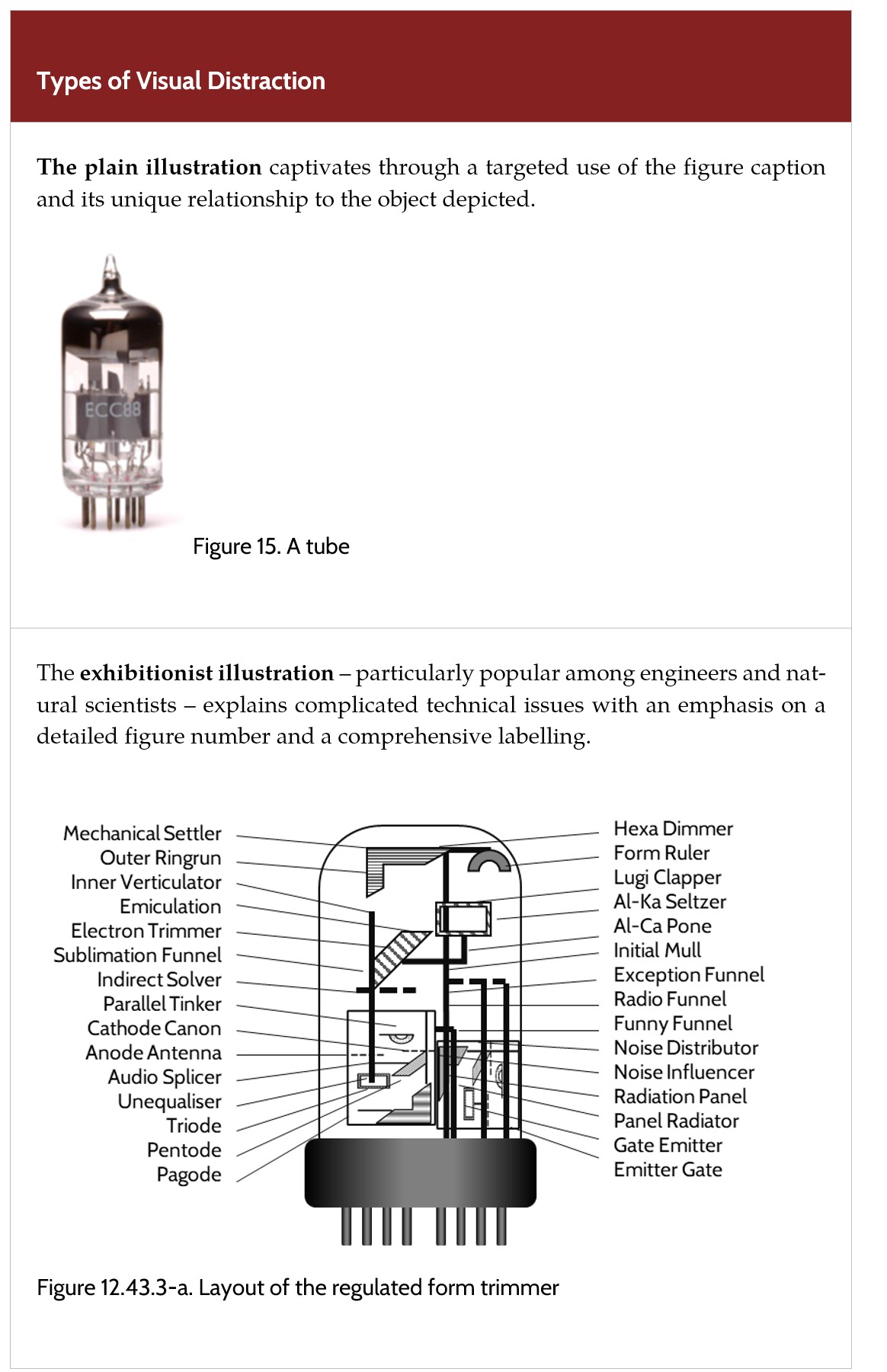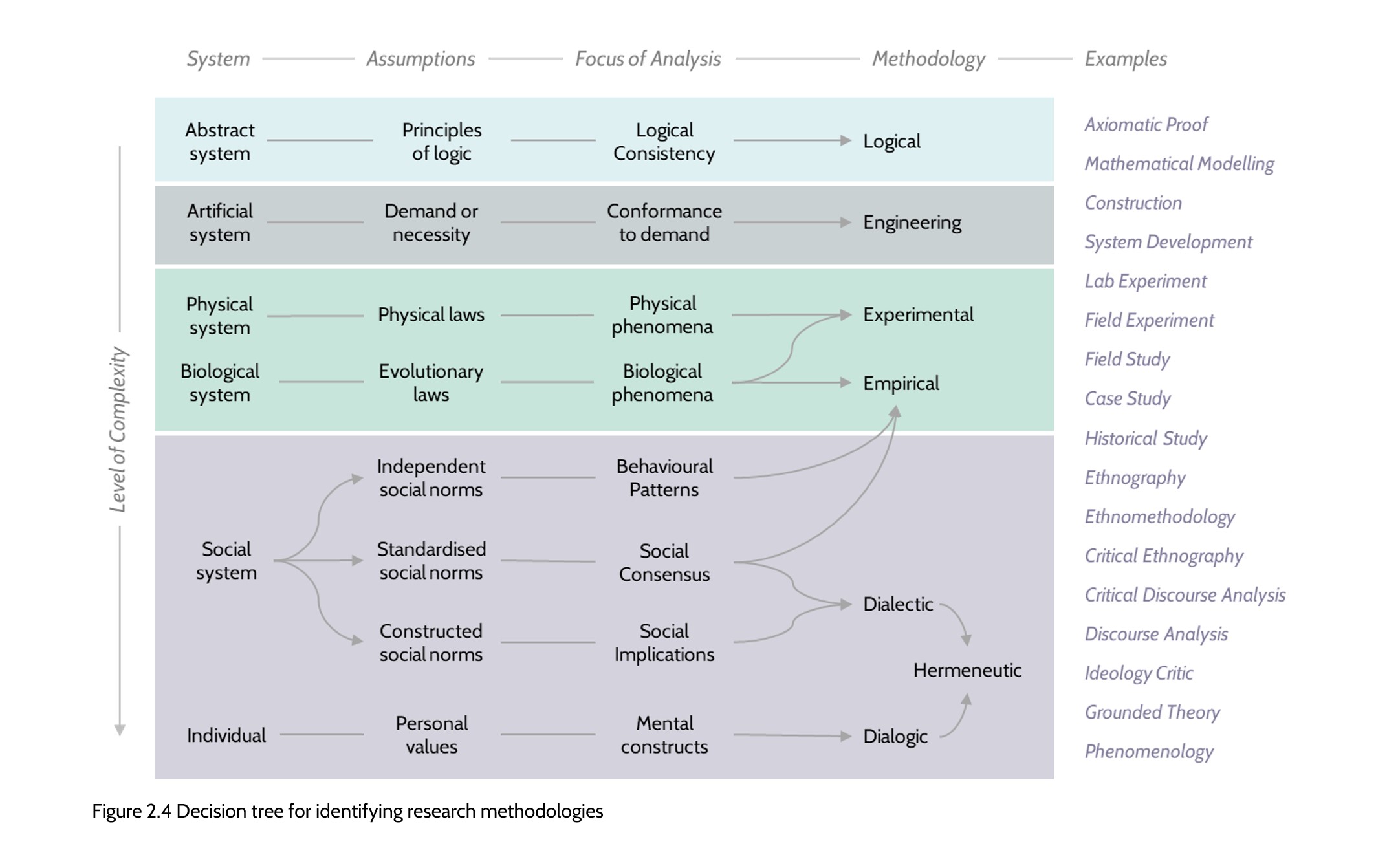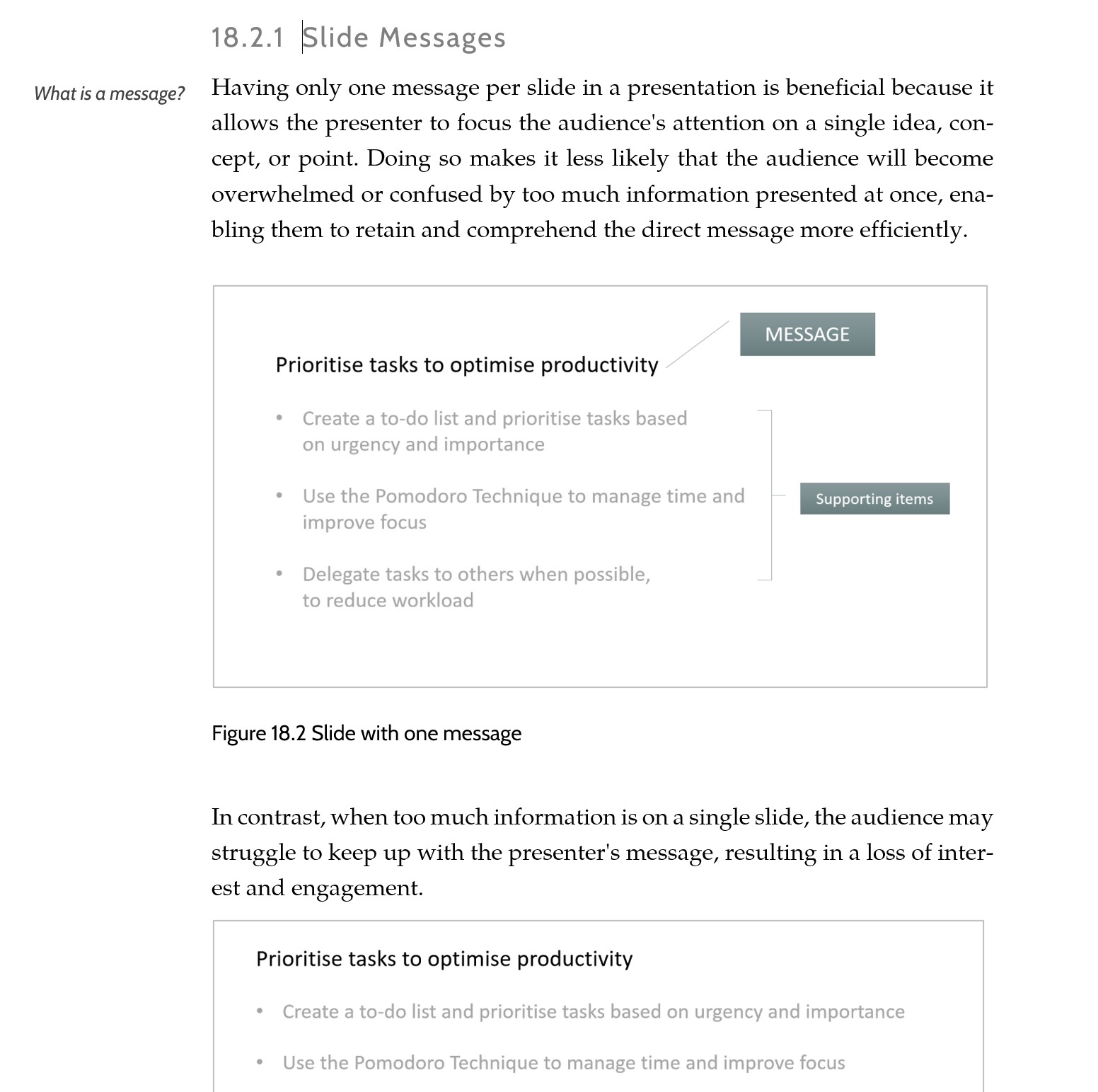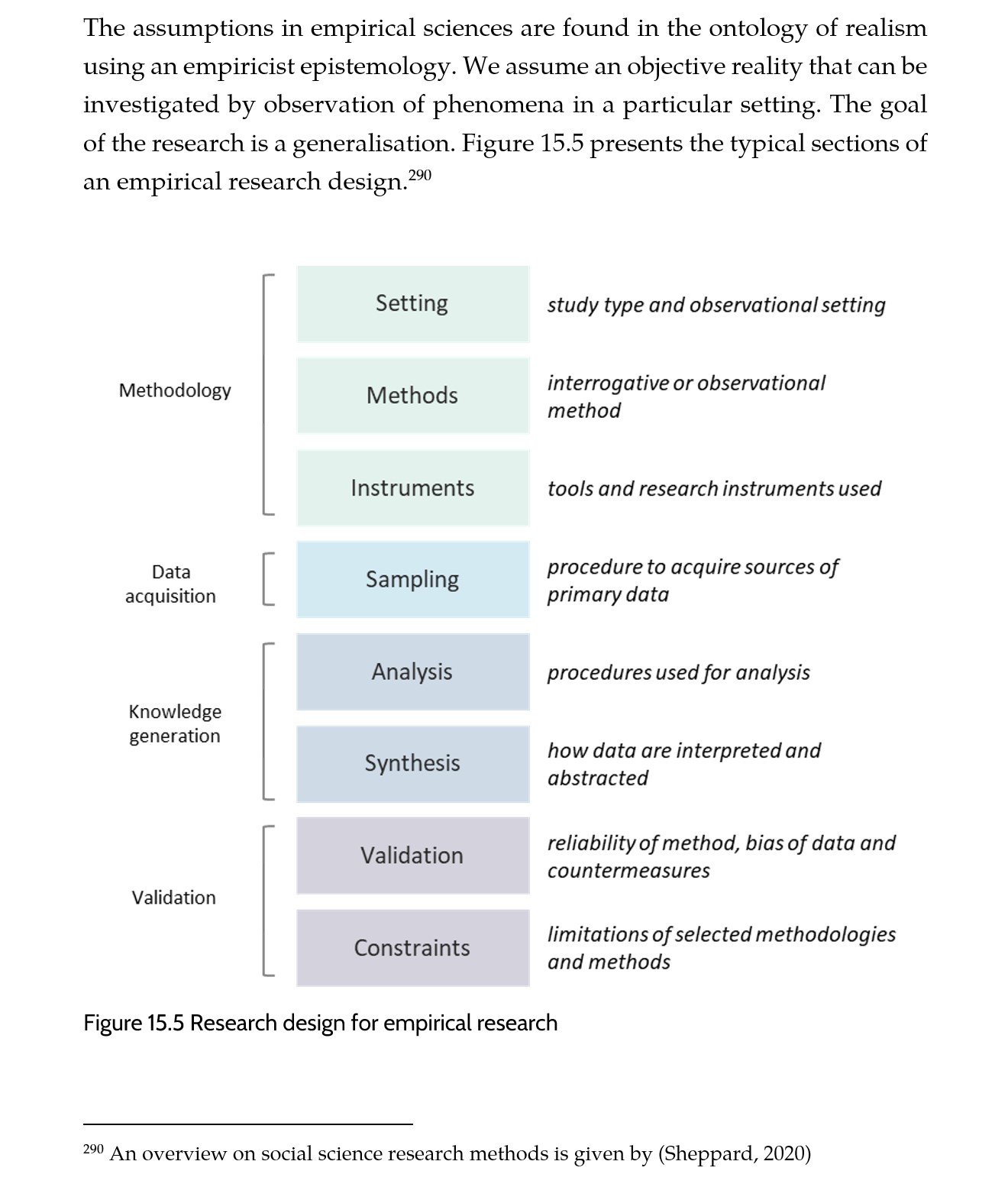The book is divided into five parts
You could engage in the:
- Science primer covering foundations of the philosophy of science, methodology, reasoning, and logic.
- Composer’s guide covering workflow, word processor, AI tools, and layout requirements.
- Creator’s guide covering the development of a thesis topic and a proposal, the storyline, stylistic requirements, and visualisation.
- Writer’s guide covering the individual sections of a thesis, distinguishing for different disciplines and approaches.
- Presenter’s guide covering presentations and thesis defence.
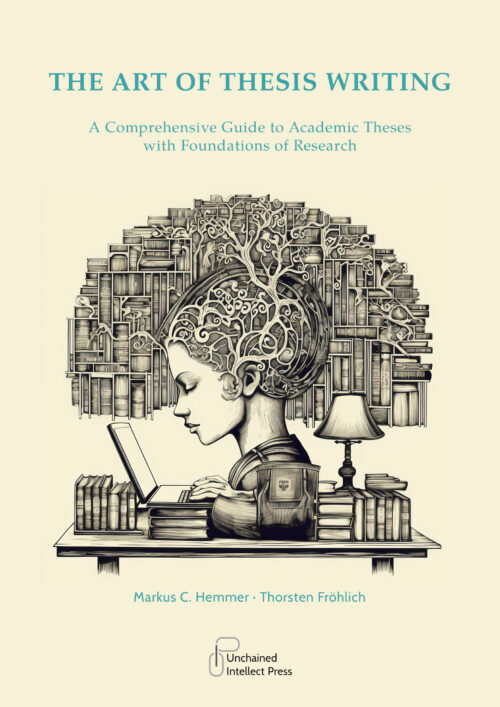
Parts
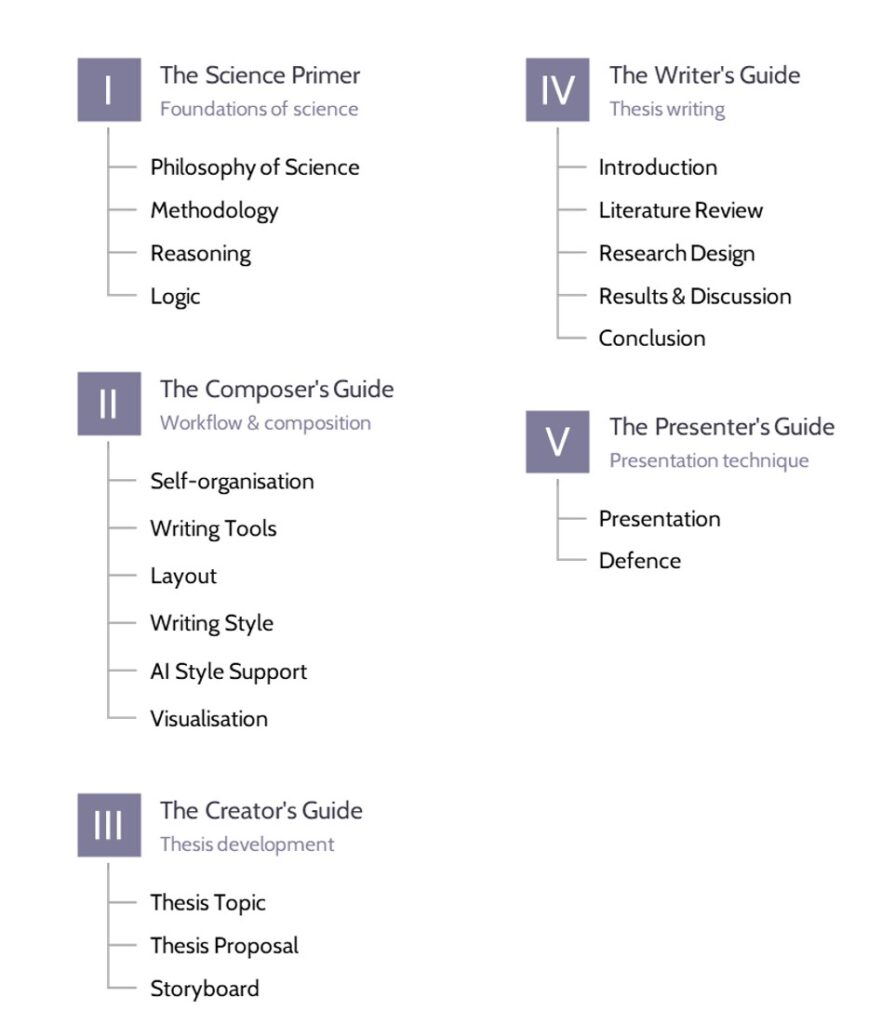
TABLE OF CONTENTS OF THE ART OF THESIS WRITING
Part I The Science Primer
1 A Field Trip Into the Sciences
1.1 Why Philosophy is Important
1.2 The Journey Begins
1.2.1 Starting with Assumptions
1.2.2 A Missing Link
1.3 The Philosophical Perspective
1.3.1 Ontology – A Matter of Reality
1.3.2 Epistemology – What Can Be Known
1.3.3 Methodology – Principles of Research
1.4 The Consequences of Ontologies
1.4.1 How the Results Differ
1.4.2 The Difference Between Theory and Practice
1.4.3 A Single Approach Does Not Suffice
1.5 A Critical Discourse
1.5.1 The Issue of Paradigms
1.5.2 The Qualitative-Quantitative Debate
1.5.3 A Matter of Definition
1.5.4 A Way Out
2 The Path to Discovery
2.1 The Research Cycle
2.2 System Complexity
2.3 Deciding for a Methodology
2.3.1 Abstract Systems
2.3.2 Artificial Systems
2.3.3 Physical Systems
2.3.4 Biological Systems
2.3.5 Social Systems
2.3.6 Individuals
2.4 From Data to Theory
2.4.1 Data and Metadata
2.4.2 Derived Data
2.4.3 Patterns and Relationships
2.4.4 Categories and Classes
2.4.5 Types and Typologies
2.4.6 Intension and Definition
2.4.7 Taxonomies
2.4.8 Models
2.4.9 Theories
3 Foundations of Reasoning
3.1 Forms of Reasoning
3.1.1 The Inference Procedure
3.1.2 Abductive Inference
3.1.3 Inductive Inference
3.1.4 Deductive Inference
3.1.5 The Subtleties of Language
3.2 Justification
3.3 Theses and Hypotheses
3.3.1 Theses
3.3.2 Hypotheses
3.3.3 A Taxonomy of Theses and Hypotheses
3.4 Abductive Reasoning in Practice
3.4.1 Medical Diagnosis
3.4.2 Grounded Theory
3.5 Inductive Reasoning
3.5.1 Eliminative Induction
3.5.2 Analogical Induction
3.5.3 Enumerative Induction
3.5.4 The Transition to Statistics
3.6 The Language of Deductive Logic
3.6.1 Definitions
3.6.2 Implication
3.6.3 Biconditional
3.6.4 Logical Operators
3.6.5 Quantifiers
3.6.6 Logical Arguments
3.6.7 Axioms, Postulates and Theorems
3.6.8 Formal Proof and Meta Language
3.7 The Traps of Reasoning
3.7.1 Ignorance of Alternatives
3.7.2 Argumentative Fallacies
3.7.3 Overgeneralisation
3.7.4 Overcomplication
3.7.5 Appeal to Authority
3.7.6 Conservatism and Common Beliefs
3.7.7 Paradox and Antinomy
3.7.8 An Issue of Precision
Part II The Composer’s Guide
4 Organise to Survive
4.1 Know Your Framework Conditions
4.2 How You are Supervised
4.3 Planning and Monitoring
4.4 Self-organisation
4.5 A Look in the Mirror
5 Quill or Word Processor?
5.1 Functions to Understand
5.2 What Else Supports Writing
5.3 Built-in Word Helpers for Finishing
5.4 A Tiny Little Helper
5.5 Saving Time Through Voice Recognition
6 Layout and Form
6.1 Basic Word Processor Functions
6.1.1 Styles
6.1.2 Fields
6.1.3 How to Copy & Paste
6.1.4 The Navigation Pane
6.2 Page Layout
6.2.1 Margins
6.2.2 Font Style and Size
6.2.3 Line Spacing
6.2.4 Paragraph Spacing vs. Indented Paragraphs
6.2.5 Headers and Footers
6.3 Section Breaks
6.3.1 Creating Landscape Pages with Section Breaks
6.3.2 Changing Page Numbering with Section Breaks
6.4 Page Breaks and Empty Lines
6.5 Headings
6.5.1 Numbering and Subdivision
6.5.2 Capitalisation
6.5.3 Punctuation
6.6 Bulleted or Numbered Lists
6.7 Footnotes and Endnotes
6.8 Emphasis
6.9 Abbreviated Forms
6.10 Front and Back Matter
6.10.1 Title Page
6.10.2 Abstract
6.10.3 Declaration of Authenticity
6.10.4 Publication Disclaimer
6.10.5 Confidentiality Clause
6.10.6 Copyright Permission
6.10.7 Dedication
6.10.8 Acknowledgements
6.10.9 Preface
6.10.10 Table of Contents
6.10.11 Listings
6.10.12 Back Matter
7 A Matter of Style
7.1 The Trouble with the Beginning
7.2 How to Write a Transition
7.3 Lonesome Headings
7.4 Headings and Expectations
7.5 Using Paragraphs
7.6 Stylistic Episodes
7.6.1 About Trivialities
7.6.2 Appropriate Terminology
7.6.3 Redundancies
7.6.4 Metaphoric Excesses
7.6.5 A Very, Very Important Rule
7.6.6 Getting it Right
7.6.7 Absolutism
7.6.8 Relativistic Considerations
7.6.9 Use of Conjunctive Adverbs
7.6.10 Verbs for Reasoning
7.6.11 Vague Qualifiers
7.6.12 Expressing an Author’s Stance
7.6.13 Active vs. Passive Voice
7.6.14 Personal Pronouns
7.7 Remarks on Punctuation
7.7.1 The Neglected Semicolon
7.7.2 Hyphens and Dashes
7.7.3 Single or Double Quotation Marks
7.8 About Citations
7.8.1 What to Cite
7.8.2 What Not to Cite
7.8.3 How to Cite
7.8.4 References
7.8.5 Plagiarism
7.9 A Style Summary in a Nutshell
8 ChatGPT and AI Tools
8.1 ChatGPT
8.2 ChatGPT and Thesis Writing
8.3 Positive And Negative Effects On Your Skills
8.3.1 Positive Effects
8.3.2 When do we Encounter Negative Effects?
8.4 AI Translation Tools
9 Visualisation
9.1 Missing Graphical Tools?
9.2 Presenting Primary and Derived Data
9.3 The Good, the Bad and the Ugly
9.4 Simple and Complex Result Types
9.4.1 Simple Result Types
9.4.2 Complex Result Types
9.5 Tables
9.5.1 Tips for Better Readability of Tables
9.5.2 What is Easier to Read?
9.6 Chart Types
9.6.1 Comparison Charts
9.6.2 Relationship Charts
9.6.3 Distribution Charts
9.6.4 Composition Charts
9.6.5 Classification Charts
9.6.6 What Chart Elements are Expected?
9.7 Source Codes
9.7.1 Monospace Fonts
9.7.2 What Code to Show and Where?
9.8 The Worst Practice
Part III The Creator’s Guide
10 From the Idea to the Topic
10.1 How to Generate a Topic
10.2 Finding Literature
10.2.1 Academic Search Engines
10.2.2 Search Phrases
10.2.3 How to Screen an Article
10.2.4 Beware of Predators
10.3 Refining your Topic
11 Writing a Thesis Proposal
11.1 Approaching Your Supervisor
11.2 Components of a Proposal
11.2.1 Describing the State
11.2.2 Phrasing the Research Objectives
11.2.3 Defining the Research Design
11.2.4 Research Schedule
11.3 Defending your Proposal
11.4 The Worst Practice
12 Creating a Storyboard
12.1 The Generic Structure
12.1.1 Introduction
12.1.2 Literature Review
12.1.3 Research Design
12.1.4 Results & Discussion
12.1.5 Conclusion
12.2 Other Forms of Studies
12.2.1 Capstone Project
12.2.2 Academic Case Study
Part IV The Writer’s Guide
13 The Introduction
13.1 How to Begin
13.2 Research Objective
13.2.1 Research Questions
13.2.2 Hypotheses
13.2.3 Thesis Statements
13.3 Value and Audience
13.4 Scope and Delimitation
13.5 The Worst Practice
14 The Literature Review
14.1 The Meaning of a Literature Review
14.1.1 Coding, Analysis, and Synthesis
14.1.2 Definitions
14.2 Types of Reviews
14.3 How Much Literature is Required
14.4 Narrative Review
14.4.1 Storyline
14.4.2 Analysis
14.4.3 Synthesis
14.5 Systematic Reviews
14.5.1 Storyline
14.5.2 Analysis
14.5.3 Synthesis
14.5.4 Limitations of Systematic Reviews
14.6 Critical Review
14.6.1 Storyline
14.6.2 Analysis
14.6.3 Synthesis
14.7 Hermeneutical Review
14.7.1 Analysis
14.7.2 Synthesis
14.7.3 Grounded Theory
14.7.4 Remarks on Grounded Theory
14.8 Meta-study
14.8.1 Storyline
14.8.2 Analysis
14.8.3 Synthesis
14.9 Meta-analysis
14.9.1 Storyline
14.9.2 Analysis
14.9.3 Synthesis
14.10 The Worst Practice
15 The Research Design
15.1 The Storyline of the Research Design
15.2 Selecting the Research Design
15.3 Formal Logic Design
15.4 Experimental Design
15.4.1 Principles
15.4.2 Conditions and Materials
15.4.3 Sampling and Pre-processing
15.4.4 Analysis and Synthesis
15.4.5 Error Analysis and Constraints
15.5 Empirical Design
15.5.1 Setting, Methods, and Instruments
15.5.2 Sampling
15.5.3 Analysis and Synthesis
15.5.4 Validation and Constraints
15.6 Interpretative Design
15.6.1 Methodology
15.6.2 Methods and Instruments
15.6.3 Analysis and Interpretation
15.6.4 Validation and Constraints
15.7 Dialectical Design
15.7.1 Methodology
15.7.2 Analysis and Synthesis
15.7.3 Validation and Constraints
15.8 Art Criticism Design
15.8.1 Assumptions
15.8.2 Deriving a Research Design
15.8.3 Target Group
15.8.4 The Role of the Receptive Audience
15.8.5 Methodical Approach
15.8.6 Analytical Focus
15.8.7 Artistic Domains and Aesthetic Elements
15.8.8 Synthesis
15.9 Engineering Design
15.9.1 Conceptual Design
15.9.2 Requirements Engineering
15.9.3 Development
15.10 A Research Design Checklist
15.11 The Worst Practice
16 The Results & Discussion
16.1 Outline of the Results Section
16.2 Explaining and Interpreting Results
16.2.1 Presentation of Charts
16.2.2 Presentation of Statistical Data
16.2.3 Presentation of Narratives
16.2.4 Presentation of Technical Results
16.3 Discussing Results
16.4 Identifying Forms of Argumentation
16.4.1 The Dialogical Argument
16.4.2 The Dialectical Argument
16.4.3 The Apodictic Argument
16.4.4 The Rhetorical Argument
16.5 Critical Assessment
16.5.1 Relevance
16.5.2 Exclusion of Alternatives
16.5.3 Causality
16.5.4 Missing Evidence
16.5.5 Consistency
16.5.6 Falsification
16.5.7 Logical Invalidation
16.5.8 Questioning Assumptions
16.5.9 Challenging Experts
16.5.10 Challenging Authorities
16.5.11 Ethical Considerations
16.5.12 Coherence
16.6 Writing a Synopsis
16.6.1 Answers to Research Questions
16.6.2 Answers to Explanatory Hypotheses
16.6.3 Answers to Statistical Hypotheses
16.6.4 Argumentation for Theses
16.6.5 Answers to Development Objectives
16.7 Results and Discussion Checklist
16.8 The Worst Practice
17 The Conclusion
17.1 Outline of the Chapter
17.2 The Conclusion
17.3 Critical Reflection
17.4 Recommendations for Future Research
17.5 Outlook
17.6 Conclusion Checklist
17.7 The Worst Practice
Part V The Presenter’s Guide
18 Presentations
18.1 Principles of Presentations
18.2 Best Practices
18.2.1 Slide Messages
18.2.2 Motion, Contrast, and Colour
18.2.3 Font Size
18.2.4 Cognitive Load
18.2.5 Background
18.2.6 Number of Elements per Slide
18.2.7 Summary
18.3 How to Present
18.3.1 Timing
18.3.2 Preparation
18.3.3 Practising
19 Thesis Defence
19.1 Objectives of a Thesis Defence
19.2 Parts of a Thesis Defence
19.2.1 Presentation
19.2.2 Question & Answer
19.2.3 Feedback
19.3 The Worst Practice

